Bin Lyu
Secure Transmission for Cell-Free Symbiotic Radio Communications with Movable Antenna: Continuous and Discrete Positioning Designs
Aug 09, 2025Abstract:In this paper, we study a movable antenna (MA) empowered secure transmission scheme for reconfigurable intelligent surface (RIS) aided cell-free symbiotic radio (SR) system. Specifically, the MAs deployed at distributed access points (APs) work collaboratively with the RIS to establish high-quality propagation links for both primary and secondary transmissions, as well as suppressing the risk of eavesdropping on confidential primary information. We consider both continuous and discrete MA position cases and maximize the secrecy rate of primary transmission under the secondary transmission constraints, respectively. For the continuous position case, we propose a two-layer iterative optimization method based on differential evolution with one-in-one representation (DEO), to find a high-quality solution with relatively moderate computational complexity. For the discrete position case, we first extend the DEO based iterative framework by introducing the mapping and determination operations to handle the characteristic of discrete MA positions. To further reduce the computational complexity, we then design an alternating optimization (AO) iterative framework to solve all variables within a single layer. In particular, we develop an efficient strategy to derive the sub-optimal solution for the discrete MA positions, superseding the DEO-based method. Numerical results validate the effectiveness of the proposed MA empowered secure transmission scheme along with its optimization algorithms.
TelePlanNet: An AI-Driven Framework for Efficient Telecom Network Planning
May 20, 2025Abstract:The selection of base station sites is a critical challenge in 5G network planning, which requires efficient optimization of coverage, cost, user satisfaction, and practical constraints. Traditional manual methods, reliant on human expertise, suffer from inefficiencies and are limited to an unsatisfied planning-construction consistency. Existing AI tools, despite improving efficiency in certain aspects, still struggle to meet the dynamic network conditions and multi-objective needs of telecom operators' networks. To address these challenges, we propose TelePlanNet, an AI-driven framework tailored for the selection of base station sites, integrating a three-layer architecture for efficient planning and large-scale automation. By leveraging large language models (LLMs) for real-time user input processing and intent alignment with base station planning, combined with training the planning model using the improved group relative policy optimization (GRPO) reinforcement learning, the proposed TelePlanNet can effectively address multi-objective optimization, evaluates candidate sites, and delivers practical solutions. Experiments results show that the proposed TelePlanNet can improve the consistency to 78%, which is superior to the manual methods, providing telecom operators with an efficient and scalable tool that significantly advances cellular network planning.
Deployment Optimization for XL-IRS Assisted Multi-User Communications
Apr 28, 2025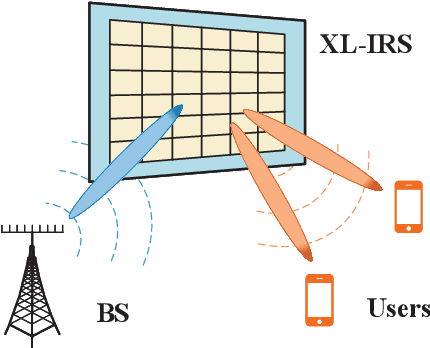

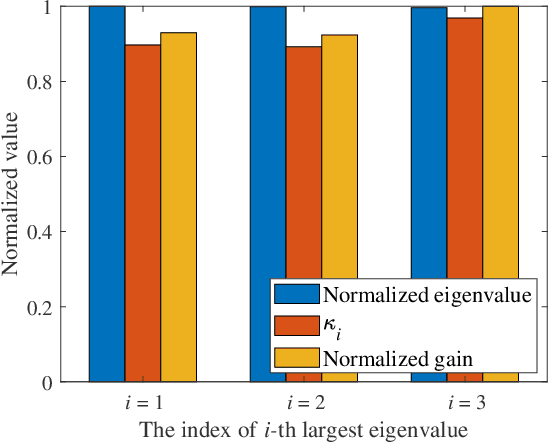
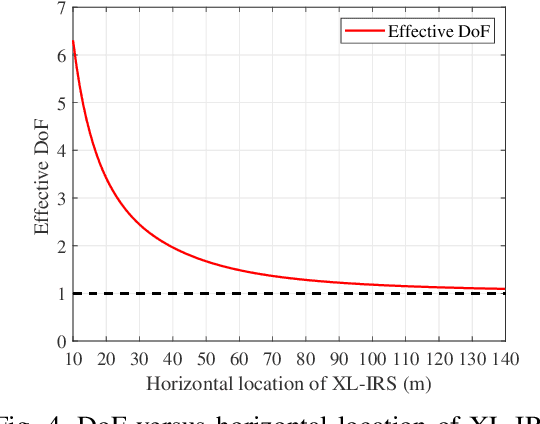
Abstract:In this paper, we study the deployment optimization for an extremely large-scale intelligent reflecting surface (XL-IRS) assisted multi-user communication system, within which the channels between the XL-IRS and the BS (or user) are modeled by the near-field spherical wavefronts. To draw some valuable insights, we first consider the single-user case, where an alternating optimization (AO) based algorithm is devised to maximize the received signal-to-noise ratio (SNR) at the user. To address the high computational complexity issue incurred by the AO based algorithm, three approximate received SNR expressions are obtained to yield useful insights, corresponding to the upper bound, approximate expression, and closed-form. It is demonstrated that the XL-IRS ought to be positioned near the user (rather than the BS) to obtain a higher beamforming gain. Then, for the multi-user scenario, an efficient algorithm is proposed to obtain a high-quality XL-IRS placement solution by using the AO and successive convex approximation (SCA) techniques. Furthermore, the effective degree of freedom (DoF) of the BS-IRS channel is provided, which indicates that the additional effective DoF can be leveraged to improve multi-user spatial multiplexing. Last, numerical results confirm the existence of a trade-off between near-field beam-focusing gain and multiplexing gain.
Robust Transmission Design for Reconfigurable Intelligent Surface and Movable Antenna Enabled Symbiotic Radio Communications
Apr 23, 2025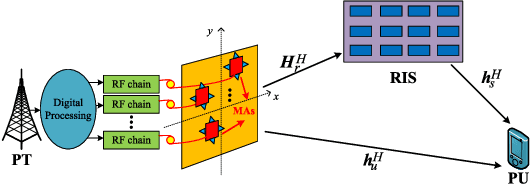
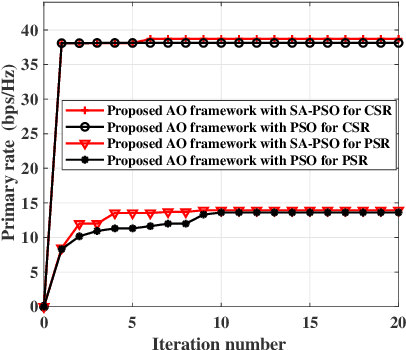
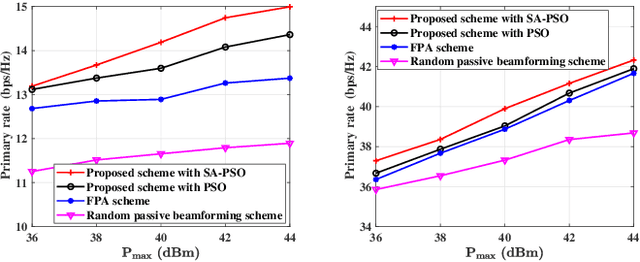
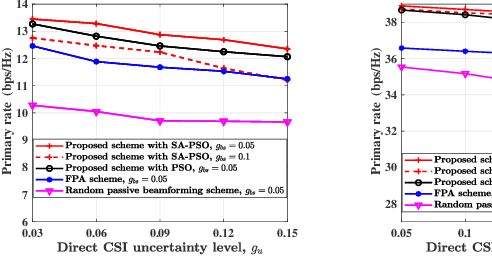
Abstract:This paper explores the application of movable antenna (MA), a cutting-edge technology with the capability of altering antenna positions, in a symbiotic radio (SR) system enabled by reconfigurable intelligent surface (RIS). The goal is to fully exploit the capabilities of both MA and RIS, constructing a better transmission environment for the co-existing primary and secondary transmission systems. For both parasitic SR (PSR) and commensal SR (CSR) scenarios with the channel uncertainties experienced by all transmission links, we design a robust transmission scheme with the goal of maximizing the primary rate while ensuring the secondary transmission quality. To address the maximization problem with thorny non-convex characteristics, we propose an alternating optimization framework that utilizes the General S-Procedure, General Sign-Definiteness Principle, successive convex approximation (SCA), and simulated annealing (SA) improved particle swarm optimization (SA-PSO) algorithms. Numerical results validate that the CSR scenario significantly outperforms the PSR scenario in terms of primary rate, and also show that compared to the fixed-position antenna scheme, the proposed MA scheme can increase the primary rate by 1.62 bps/Hz and 2.37 bps/Hz for the PSR and CSR scenarios, respectively.
Exploiting NOMA Transmissions in Multi-UAV-assisted Wireless Networks: From Aerial-RIS to Mode-switching UAVs
Dec 29, 2024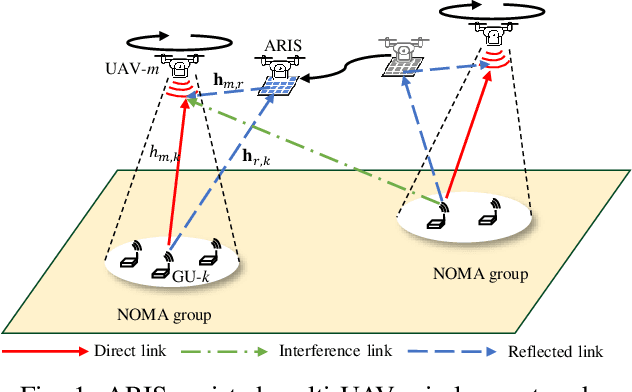
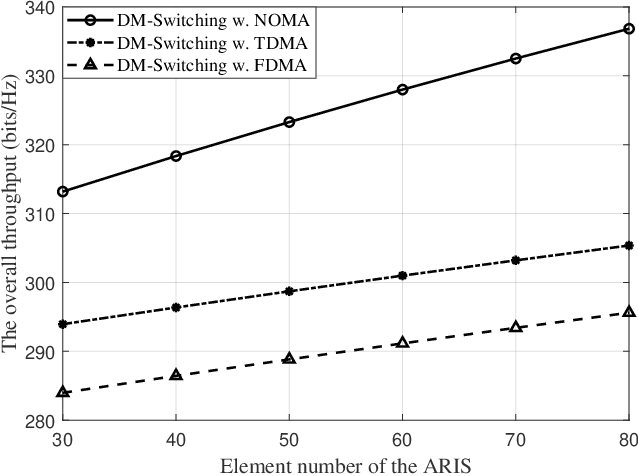
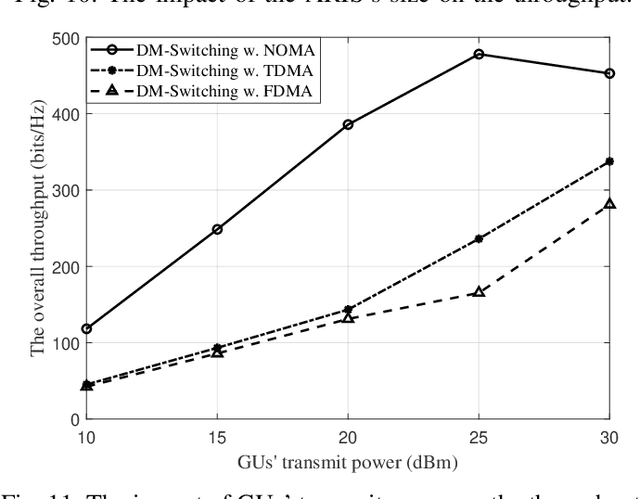
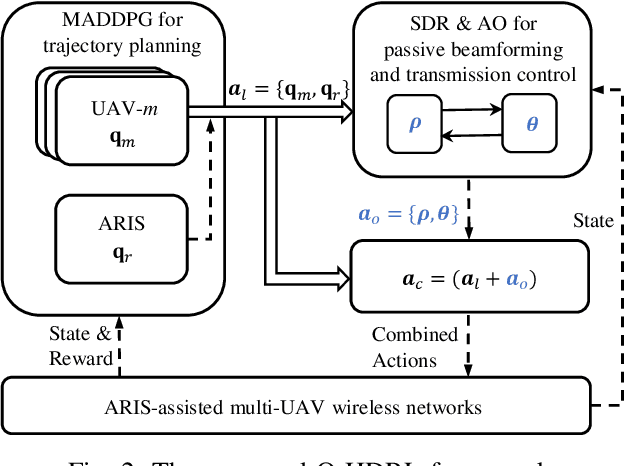
Abstract:In this paper, we consider an aerial reconfigurable intelligent surface (ARIS)-assisted wireless network, where multiple unmanned aerial vehicles (UAVs) collect data from ground users (GUs) by using the non-orthogonal multiple access (NOMA) method. The ARIS provides enhanced channel controllability to improve the NOMA transmissions and reduce the co-channel interference among UAVs. We also propose a novel dual-mode switching scheme, where each UAV equipped with both an ARIS and a radio frequency (RF) transceiver can adaptively perform passive reflection or active transmission. We aim to maximize the overall network throughput by jointly optimizing the UAVs' trajectory planning and operating modes, the ARIS's passive beamforming, and the GUs' transmission control strategies. We propose an optimization-driven hierarchical deep reinforcement learning (O-HDRL) method to decompose it into a series of subproblems. Specifically, the multi-agent deep deterministic policy gradient (MADDPG) adjusts the UAVs' trajectory planning and mode switching strategies, while the passive beamforming and transmission control strategies are tackled by the optimization methods. Numerical results reveal that the O-HDRL efficiently improves the learning stability and reward performance compared to the benchmark methods. Meanwhile, the dual-mode switching scheme is verified to achieve a higher throughput performance compared to the fixed ARIS scheme.
Detecting and Classifying Defective Products in Images Using YOLO
Dec 22, 2024



Abstract:With the continuous advancement of industrial automation, product quality inspection has become increasingly important in the manufacturing process. Traditional inspection methods, which often rely on manual checks or simple machine vision techniques, suffer from low efficiency and insufficient accuracy. In recent years, deep learning technology, especially the YOLO (You Only Look Once) algorithm, has emerged as a prominent solution in the field of product defect detection due to its efficient real-time detection capabilities and excellent classification performance. This study aims to use the YOLO algorithm to detect and classify defects in product images. By constructing and training a YOLO model, we conducted experiments on multiple industrial product datasets. The results demonstrate that this method can achieve real-time detection while maintaining high detection accuracy, significantly improving the efficiency and accuracy of product quality inspection. This paper further analyzes the advantages and limitations of the YOLO algorithm in practical applications and explores future research directions.
Channel Estimation for XL-IRS Assisted Wireless Systems with Double-sided Visibility Regions
Aug 30, 2024



Abstract:In this paper, we study efficient channel estimation design for an extremely large-scale intelligent reflecting surface (XL-IRS) assisted multi-user communication systems, where both the base station (BS) and users are located in the near-field region of the XL-IRS. Two unique channel characteristics of XL-IRS are considered, namely, the near-field spherical wavefronts and double-sided visibility regions (VRs) at the BS and users, which render the channel estimation for XL-IRS highly challenging. To address this issue, we propose in this paper an efficient three-step XL-IRS channel estimation method. Specifically, in the first step, an anchor node is delicately deployed near the XL-IRS to estimate the cascaded BS-IRS-anchor channel. Then, an efficient VR detection method is devised to estimate the VR information between the BS and XL-IRS. In this way, only the channels from the visible XL-IRS elements to the BS are estimated, thereby reducing the dimension of the cascaded BS-IRS-users channels to be estimated. Third, by leveraging the common BS-IRS channel, the cascaded channels for all users are consecutively estimated accounting for the VRs of the IRS-user channels. Finally, numerical results are provided to demonstrate the effectiveness of our proposed channel estimation scheme as compared to various benchmark schemes.
Movable Antenna Enabled Symbiotic Radio Systems: An Opportunity for Mutualism
Aug 11, 2024



Abstract:In this letter, we propose a new movable antenna (MA) enabled symbiotic radio (SR) system that leverages the movement of MAs to maximize both the primary and secondary rates, thereby promoting their mutualism. Specifically, the primary transmitter (PT) equipped with MAs utilizes a maximum ratio transmission (MRT) beamforming scheme to ensure the highest primary rate at the primary user (PU). Concurrently, the backscatter device (BD) establishes the secondary transmission by overlaying onto the primary signal. The utilization of MAs aims to enhance the secondary rate by optimizing the positions of MAs to improve the beam gain at the BD. Accordingly, the beam gains for both MA and fixed-position antenna (FPA) scenarios are analyzed, confirming the effectiveness of the MA scheme in achieving the highest primary and secondary rates. Numerical results verity the superiority of our proposed MA enabled scheme.
Secure Transmission for Movable Antennas Empowered Cell-Free Symbiotic Radio Communications
Aug 08, 2024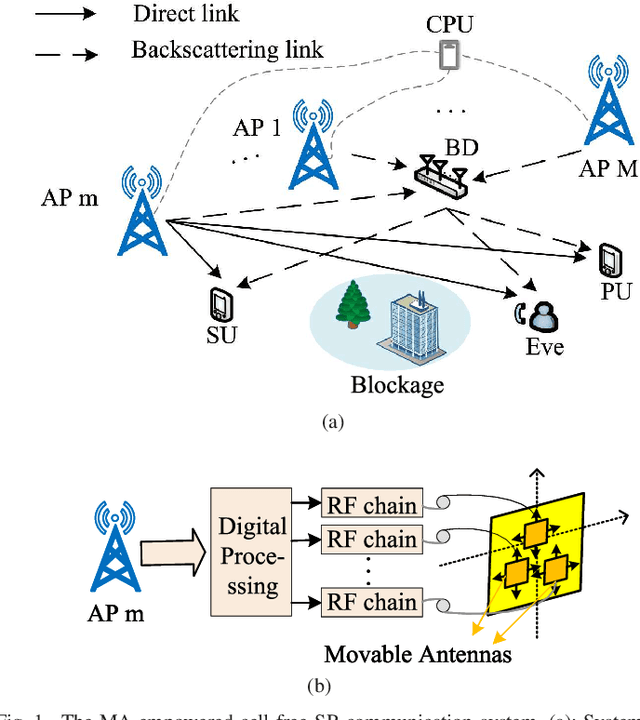
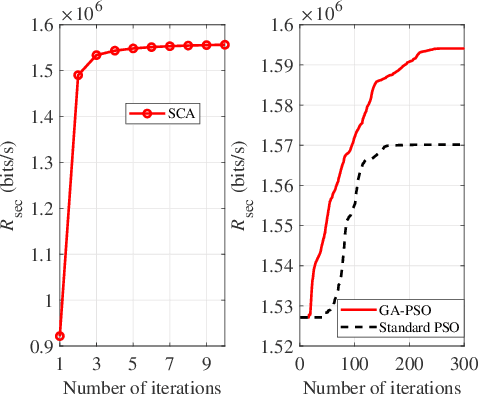
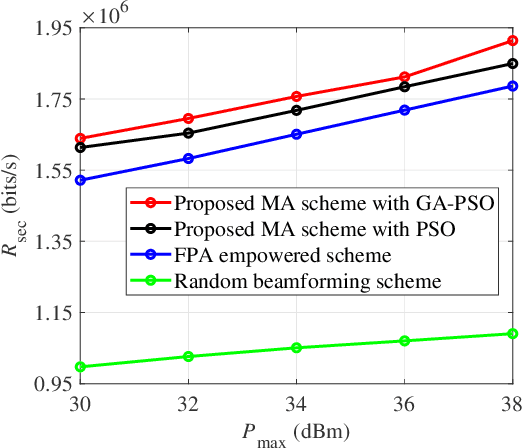
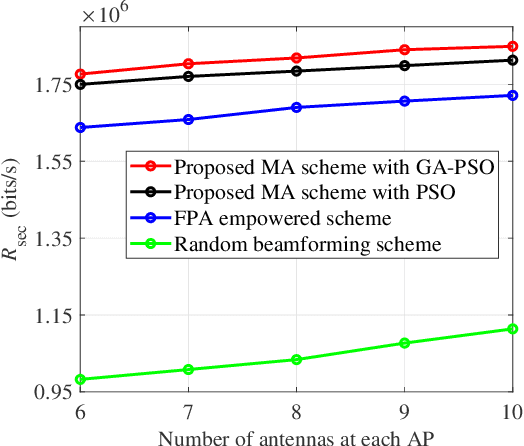
Abstract:In this paper, a novel movable antenna (MA) empowered secure transmission scheme is designed for cell-free symbiotic radio (SR) systems in the presence of an eavesdropper (Eve). Specifically, multiple distributed access points (APs) equipped with MAs collaboratively transmit confidential information to the primary user (PU), in the meanwhile the backscatter device (BD) transmits its own information to the secondary user (SU) by reflecting incident signals from the APs. The MAs deployed at the APs can adjust their positions flexibly to improve channel conditions between the APs and the PU/SU/BD and suppress the eavesdropping from the Eve on confidential information at the PU. Under this setup, we maximize the secrecy rate of primary transmission through jointly optimizing the APs' transmission beamforming vectors and the positions of the MAs, while adhering to the quality of service constraints at the SU. To address the challenges caused by the non-convexity and find a near-optimal solution, an alternating optimization (AO) framework is proposed, utilizing the successive convex approximation method, the semi-definite relaxation technology and a genetic algorithm modified particle swarm optimization (GA-PSO) algorithm. Numerical results demonstrate the secrecy rate enhancement provided by utilizing the MAs and show the impact of the GA-PSO algorithm for improving the solving accuracy.
Movable Antenna-Enhanced Wireless Powered Mobile Edge Computing Systems
Apr 29, 2024



Abstract:In this paper, we propose a movable antenna (MA) enhanced scheme for wireless powered mobile edge computing (WP-MEC) system, where the hybrid access point (HAP) equipped with multiple MAs first emits wireless energy to charge wireless devices (WDs), and then receives the offloaded tasks from the WDs for edge computing. The MAs deployed at the HAP enhance the spatial degrees of freedom (DoFs) by flexibly adjusting the positions of MAs within an available region, thereby improving the efficiency of both downlink wireless energy transfer (WPT) and uplink task offloading. To balance the performance enhancement against the implementation intricacy, we further propose three types of MA positioning configurations, i.e., dynamic MA positioning, semi-dynamic MA positioning, and static MA positioning. In addition, the non-linear power conversion of energy harvesting (EH) circuits at the WDs and the finite computing capability at the edge server are taken into account. Our objective is to maximize the sum computational rate (SCR) by jointly optimizing the time allocation, positions of MAs, energy beamforming matrix, receive combing vectors, and offloading strategies of WDs. To solve the non-convex problems, efficient alternating optimization (AO) frameworks are proposed. Moreover, we propose a hybrid algorithm of particle swarm optimization with variable local search (PSO-VLS) to solve the sub-problem of MA positioning. Numerical results validate the superiority of exploiting MAs over the fixed-position antennas (FPAs) for enhancing the SCR performance of WP-MEC systems.
 Add to Chrome
Add to Chrome Add to Firefox
Add to Firefox Add to Edge
Add to Edge